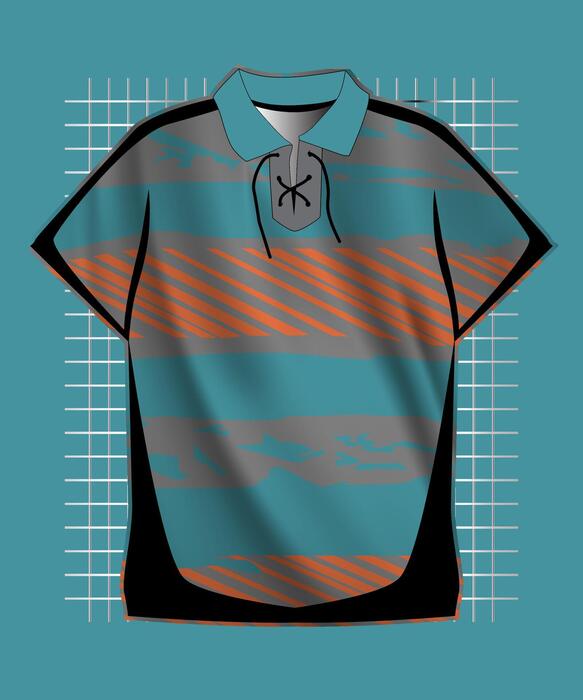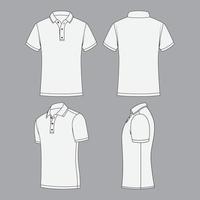Polo shirts are a cornerstone of both casual and professional wardrobes. Their classic collar, button placket, and comfortable pique knit fabric make them a popular choice for everything from corporate uniforms to sports teams, and even everyday wear. When it comes to personalization, embroidery is often the preferred method, offering a durable, high-quality finish that screen printing simply can't match. But while a well-digitized logo or text is essential, there's a subtle yet powerful element that can truly elevate an embroidered polo shirt: the background design.
You might be thinking, "a background for embroidery?" Yes, it's not about literally embroidering a landscape behind your logo. Instead, we're talking about those complementary design elements – frames, shields, banners, crests, or subtle patterns – that provide context, enhance visual appeal, and give your main design a professional, finished look. These elements can transform a simple logo into a sophisticated emblem, making your polo shirt stand out from the crowd. If you're looking to add that extra touch of class and distinction to your embroidered polo shirts, understanding how to find, download, and utilize these background designs is a game-changer. This article will guide you through everything you need to know, from understanding what these backgrounds are to where to find the best ones and how to use them effectively.
Understanding "Polo Shirt Background" in Embroidery Designs
When we talk about an "embroidery design background" for a polo shirt, we're referring to a supporting design element that frames, anchors, or complements your primary embroidered motif (like a company logo, monogram, or team name). It's not a literal image background, but rather a structural or decorative element that enhances the overall composition.
Think of it like this: a painting often looks more complete when placed in a beautiful frame. Similarly, an embroidered logo can gain significant presence and professionalism when nestled within a well-chosen background design. These elements provide a visual foundation, adding depth and interest without necessarily being the main focal point. Common examples include:
- Shields and Crests: Giving a classic, authoritative feel, perfect for clubs, schools, or traditional brands.
- Wreaths and Laurels: Conveying achievement, honor, or natural elegance.
- Banners and Ribbons: Ideal for displaying text, dates, or taglines, adding a dynamic touch.
- Frames and Borders: Simple geometric or ornate designs that neatly enclose your main motif.
- Subtle Textures or Patterns: Lightly stitched elements that fill space without overwhelming the main design.
The beauty of these background designs lies in their ability to make a standard logo feel more substantial, more integrated, and ultimately, more impactful on the fabric of a polo shirt.
Why Use Background Designs for Polo Shirts?
Adding a background design to your polo shirt embroidery isn't just about aesthetics; it offers several practical and branding advantages:
- Enhanced Professionalism: A well-designed background elevates a simple logo, giving it a more polished and established appearance, crucial for corporate wear or uniforms.
- Stronger Brand Identity: Consistent use of a specific background element (like a unique shield shape or a particular frame) helps reinforce brand recognition and creates a cohesive visual identity across different garments.
- Increased Visual Appeal: These elements add visual interest and complexity, making the embroidered design more engaging and attractive to the eye. They can transform a plain logo into a piece of art.
- Versatility in Design: A single logo can be adapted to various contexts by simply changing its background. A company logo might be placed in a formal shield for executive polos, or a more casual banner for team events.
- Optimal Space Utilization: Backgrounds can help fill out the embroidery area on a polo shirt (like the left chest) without making the main logo disproportionately large. This creates a balanced look.
- Problem Solving: In some cases, a background can help stabilize the fabric around a delicate design or subtly mask minor imperfections in the fabric's weave, especially on pique knits.
Ultimately, a thoughtful background design communicates attention to detail and a commitment to quality, reflecting positively on the wearer or the brand they represent.
Where to Find High-Quality Embroidery Design Backgrounds
The digital world offers a treasure trove of embroidery designs, but knowing where to look for quality background elements is key. Here are the best places to start your search:
Dedicated Embroidery Design Websites
These are your go-to sources. Many reputable sites specialize in machine embroidery designs and offer extensive libraries. Look for categories like "frames," "borders," "crests," "shields," "appliqué backgrounds," or "decorative elements."
- Premium Design Sites: Websites like Urban Threads, EmbroideryDesigns.com, OESD, or Great Notions often feature professionally digitized designs. They usually offer designs in various formats (DST, PES, JEF, HUS, VP3, XXX, etc.) to suit different embroidery machines.
- Independent Digitizers/Etsy Shops: Many talented independent digitizers sell their unique creations on platforms like Etsy. You might find more niche or artistic background designs here. Always check reviews and the seller's reputation.
Generic Stock Design Sites (with caution)
While sites like Shutterstock or Adobe Stock offer vector graphics, these are not directly usable for embroidery. If you find a vector graphic you love, you'll need to have it professionally digitized into an embroidery file format. This adds an extra step and cost, but opens up a vast array of design possibilities.
Custom Digitizing Services
If you have a very specific vision for a background design that you can't find off-the-shelf, a professional embroidery digitizing service can create a custom file for you. This ensures the design is perfectly tailored to your needs and optimized for embroidery on polo shirt fabric.
Free Design Sites (exercise caution)
There are websites offering free embroidery designs. While tempting, the quality can vary significantly. Always check the licensing (personal vs. commercial use) and be prepared to test stitch these designs thoroughly before using them on a final garment. Sometimes, "free" can end up costing more in wasted time and materials if the digitization is poor.
Embroidery Software Built-in Libraries
Many modern embroidery software packages (like Embrilliance, Hatch, or Wilcom) come with a library of basic shapes, frames, and decorative elements. These can be a great starting point for simple background designs or for combining with other elements.
Key Considerations Before Downloading
Before you click that download button, keep these important factors in mind to ensure a smooth embroidery process and a fantastic final product:
- File Format Compatibility: Ensure the design file format (e.g., PES for Brother/Babylock, DST for Tajima, JEF for Janome, HUS for Husqvarna/Viking) is compatible with your specific embroidery machine.
- Design Size: Check the dimensions of the background design. Will it fit within the available embroidery area on your polo shirt (e.g., left chest, sleeve, back yoke)? Remember that scaling designs too much can affect stitch density and quality.
- Stitch Count and Density: A higher stitch count means more thread and longer embroidery time. While not always a deal-breaker, be aware of how dense the design is. Overly dense designs can make the fabric stiff.
- Thread Colors: Most designs come with suggested thread colors, but you should be able to easily change them in your embroidery software to match your brand colors or aesthetic preferences.
- Licensing: Understand the terms of use. Is the design licensed for personal use only, or can it be used for commercial projects (e.g., embroidering polos for clients)?
- Digitization Quality: Look for designs that appear well-digitized in their preview images – smooth curves, clean edges, and appropriate fill patterns. Read reviews if available.
- Reviews and Reputation: If buying from an independent designer or a less-known site, check customer reviews to gauge the quality of their designs and customer service.
Tips for Using Background Designs on Polo Shirts
Once you've downloaded your perfect background design, here's how to integrate it effectively into your polo shirt embroidery project:
- Strategic Placement: The left chest is the most common spot for polo shirt embroidery. Ensure the background design complements the main logo and fits well in this area. Consider sleeves or the back yoke for additional branding.
- Careful Sizing: If you need to resize the background design, do so within your embroidery software, keeping scaling proportional to avoid distortion. Test stitch if you're making significant changes.
- Color Harmony: Choose thread colors for the background that complement both the polo shirt fabric and your main logo. Subtle, tone-on-tone colors often work best for backgrounds, allowing the main logo to pop.
- Layering with Your Main Logo: Most background designs are intended to be stitched first, with your main logo then placed on top. Ensure your embroidery software allows for proper layering and sequencing of design elements.
- Stabilization is Key: Polo shirts are often made from pique knit, which can be stretchy. Use appropriate backing (cut-away stabilizer is usually best for knits) to prevent puckering and ensure a crisp design.
- Test Stitch, Always: Before embroidering on your final polo shirt, always perform a test stitch on a scrap piece of similar fabric. This allows you to check colors, sizing, stitch quality, and machine tension.
Final Summary
Incorporating a well-chosen background design into your polo shirt embroidery can significantly elevate the final product, adding professionalism, visual appeal, and a strong sense of brand identity. From understanding what these "backgrounds" entail – such as shields, wreaths, and frames – to knowing where to find high-quality digitized files on dedicated design websites, stock sites, or through custom digitizing, the options are vast. Remember to consider crucial factors like file format, size, licensing, and digitization quality before downloading. Finally, effective use involves careful placement, harmonious color choices, proper stabilization, and always, a test stitch. By following these guidelines, you'll transform ordinary polo shirts into distinguished garments that truly stand out.




